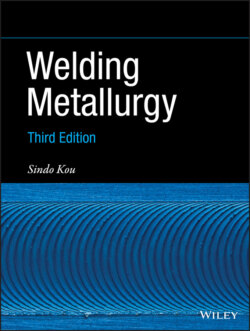Читать книгу Welding Metallurgy - Sindo Kou - Страница 97
3.4.3 Physical Simulation of Fluid Flow and Weld Penetration
ОглавлениеKou and Sun [23] conducted bead‐on‐plate welding of Wood's metal as a physical simulation of the effect of the Lorentz force on weld penetration. Since the Wood's metal has a very low melting of about 70 °C, it is possible to use a heated Cu rod in contact with its top surface as a heat source for welding. Figure 3.19 shows the transverse cross‐sections of the welds. The transverse cross‐section of the weld is essentially a semicircle. However, with a 75 A current going through to the Cu rod into the weld pool (no arcing and negligible resistance heating), the weld becomes much deeper. This physical simulation proves the Lorentz force deepens the weld penetration.
Figure 3.19 Welds in Wood's metal produced under the influence of: (a) buoyancy force: (b) Lorentz force.
Source: Kou and Sun [23]. © TMS.
The direction of Marangoni flow on the weld pool surface can be identified by using tracers that float on the surface. Figure 3.20 shows a bead‐on‐plate weld of a 304 stainless steel containing a low sulfur level of 40 ppm. To avoid keyholing, the YAG laser beam was defocused to 6 mm in diameter (conduction mode). Two dark patches of slag that formed by themselves on the weld pool surface are visible on the weld top surface. The smaller one on the left was pushed to the trailing edge of the weld pool surface during welding. The larger one on the right, on the other hand, was pushed to the leading edge. Thus, in both cases, Marangoni flow was outward along the weld pool surface toward the pool edge, consistent with the expected outward Marangoni flow in the absence of a significant amount of surface‐active agent.
Figure 3.20 Bead‐on‐plate weld of 304 stainless steel with 40 ppm sulfur made by conduction‐mode laser beam welding at 3 kW and 7.62 mm/s. Dark slag patches at the leading and trailing portions of the pool boundary indicate outward surface flow during welding.
Source: Chao and Kou [34].
Heiple's theory represents a major milestone in welding science and should be verified, especially the reversal of Marangoni flow by a surface‐active agent. The computer simulation of Sun and Kou [23] was the first theoretical verification of the reversed Marangoni flow and deepened weld penetration caused by a surface‐active agent. Although this was significant, the most direct verification is still flow visualization, that is, to actually see the flow going inward along the pool surface and downward along the pool axis when the surface‐active agent is present. Since liquid metal is opaque to visible light, visualization of fluid flow below the weld pool surface is difficult to do.
Limmaneevichitr and Kou [40] conducted physical simulation of weld‐pool Marangoni flow using a transparent pool of molten NaNO3 (307 °C melting point). The pool was hemispherical in shape with a concave free surface that was heated at the center by a defocused CO2 laser beam as illustrated in Figure 3.21. NaNO3 has a ∂γ/∂T = − 0.056 dyne/cm/°C. Since its transmission range is from 0.35 to 3 μm, NaNO3 is opaque to CO2 laser (10.6 μm wavelength) just like a metal weld pool is opaque to an arc. By using a thin sheet of He‐Ne laser (red light), either vertical [40] or horizontal [32], to illuminate tiny tracer particles suspended in the pool, the flow pattern in the pool can be revealed clearly.
Figure 3.21 Visualization of Marangoni flow using laser light‐cut technique: (a) vertical light sheet [40]; (b) horizontal light sheet [32].
Source: Limmaneevitchitr, Kou, Wei. Welding Journal, May 2000 and December 2011, © American Welding Society
.
Figure 3.22a shows the flow pattern induced by a CO2 laser beam of 2.5 W power and 3.2 mm diameter [40]. The narrow band above the pool surface is from the mirror image of the flow lines near the pool surface, and the arrows in the band indicate the directions of flow at the pool surface. Two counterrotating cells are, in fact, the two intersections between the donut‐shaped flow pattern and the meridian plane of the pool. The outward surface flow is much faster than the inward return flow, which is typical of Marangoni convection. As the beam diameter is reduced, convection grows stronger and penetrates deeper.
Figure 3.22 Verifying effect of surface‐active agent on Marangoni flow using NaNO3: (a) outward flow; (b) inward flow in a NaNO3 pool containing 2 mol% C2H5COOK as a surface‐active agent.
Source: Limmaneevitchitr and Kou [40, 41]. Welding Journal, May 2000 and November 2000, © American Welding Society.
It is worth noting that in conduction‐mode (no keyholing) laser beam welding, the pool surface can be concave due to Marangoni convection and surface tension [32] and, in fact, this has been shown to be the case experimentally [42] and by computer simulation [43]. The concave NaNO3 pool surface in Figure 3.22, however, is just a coincidence – that is, the melt wets the container wall and the meniscus makes the pool surface concave.
Limmaneevichitr and Kou [41] added 2 mol% of C2H5COOK to the NaNO3 pool as a surface‐active agent and reversed the direction of Marangoni flow. C2H5COOK reduces the surface tension of NaNO3 significantly. Its effect on ∂γ/∂C is −22 dyne/cm/mol% [44]. Since the heating of the CO2 laser beam decomposes C2H5COOK and makes it ineffective, the surface tension is now higher near the center of the pool surface instead of lower as in the case of the pure NaNO3 pool. As shown in Figure 3.22b, the flow is now inward along the pool surface and downward along the pool axis, thus confirming Marangoni flow is indeed reversed and deeper penetrating.
